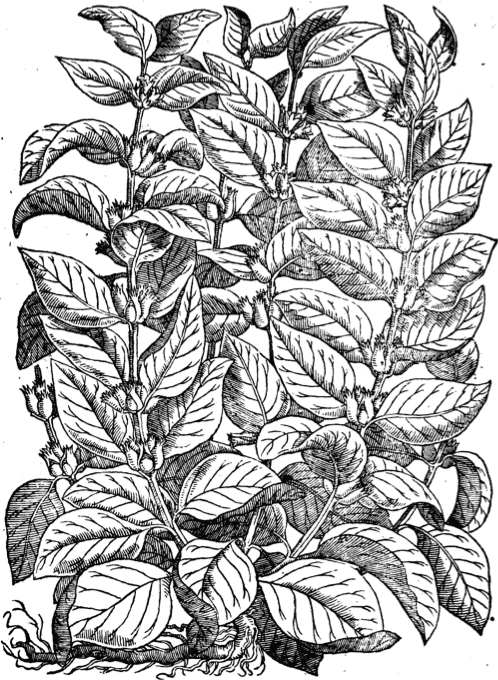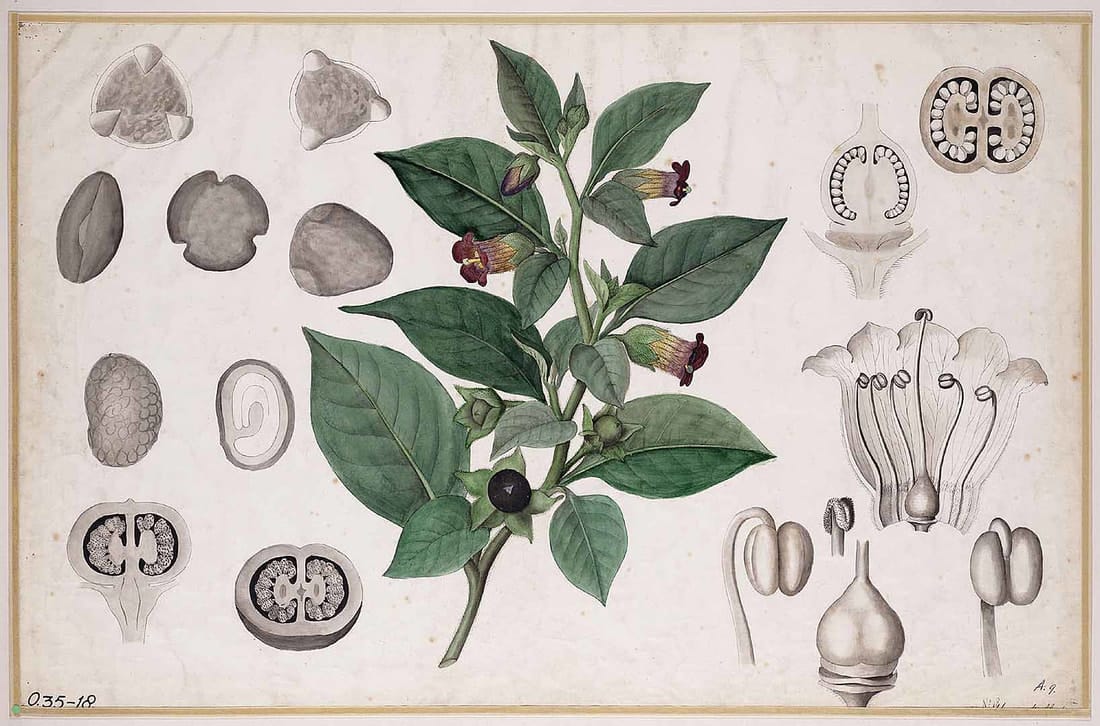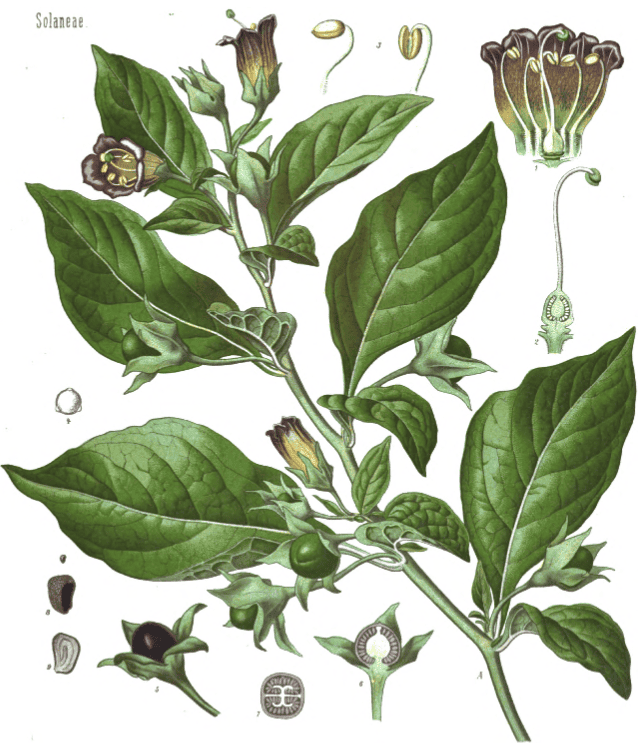Belladonna, Deadly NightshadeSolanum lethale, Devil’s Herb, HypnoticonMorella furiosum lethale (Dioscorides), Strychnos manikon (Pliny) |

|

|
 New Kreuterbuch, Matthiolus, 1563
New Kreuterbuch, Matthiolus, 1563 Botanische wandplaten, 1904–1914
Botanische wandplaten, 1904–1914 Kohler’s Medizinal Pflanzen, 1887
Kohler’s Medizinal Pflanzen, 1887

|

|
|
Belladonna root 1, Large root with a finely wrinkled and abraded surface. 2. Stem of the plant. 3. White abraded surface. 4. Dark cambium separating the cortex and wood. 5, White starchy wood. 6. Dark resinous wood. Squibb’s Atlas of the Official Drugs, Mansfield, 1919 |
Belladonna root Notes on Pharmacognosy, Otto Augustus Wall, 1902 |
Botanical name:
Atropa belladonna
Parts used:
Leaf, Root
Temperature & Taste:
Cold, dry. Pungent, Bitter. Toxic
Classifications:
2I. ANTISPASMODICS. 2O. ASTRINGENTS
3I. APHRODISIACS
TCM:
I. Medicines for Internal Wind
Q. Stop Cough and Wheezing
T. External Medicines
Uses:
1. Clears Heat and Toxins:
-acute sore throat with difficulty swallowing
-acute heat diseases such as Typhoid and Scarlet fevers
-Meningitis (especially with dullness and congestion), and for chronic Encephalitis (in greater than full doses, which are well tolerated in this condition).
-relieves sweating and inflammation in Phthisis, Pneumonia, and other exhausting or wasting diseases.
–Hahnemann proved the tincture given in very small doses could protect from the infection of Scarlet fever.
-Choroiditis with burning and dryness of the eyes, and early stages of conjunctivitis.
-Graves Disease (‘striking’ improvement; Lancet, 1911)
2. Clears Heat, Calms Spasms, Stops Pain:
-Spasmodic Coughs and Asthma (often given in cigarettes or the burnt herb is used as an inhalation);
-Renal or biliary colic.
-Palpitations; relieves the pain and anxiety often accompanying. (topically over the chest and internally)
-Parkinsonism; Delirium Tremens
-Motion Sickness.
-Comatosed patients; Concussion
-“used in curing coma” (Avicenna)
-Cerebral congestion with delirium, red eyes, hot head but cold feet, and a purple colored face, lips, and tongue.
3. Calms the Mind, Promotes Rest, Stops Pain:
-Insomnia (Avicenna)
-Psychoses, Mania, Insanity.
-traditionally as an anaesthetic for use during amputations and cautery. (Avicenna)
-‘Successful in obesity associated with a voracious appetite’. (British Medical Journal, 1910)
4. Clears Heat, Resolves Swellings and Masses:
-Tumors and Cancer; including Breast Cancer (topically and internally)
–Galen used it for Tumors and Cancer, and it was still used for this purpose until the 17th century; later being given internally and used externally.
5. Calms the Stomach, Stops Spasms:
-‘unparalleled as a gastrointestinal antispasmodic and is superior to all of the available synthetic drugs’. (Weiss)
6. Stops Leakages:
-‘No drug can compare with it in checking the secretions of Milk, Sweat and Saliva’. (Squires)
-sweating associated with Tuberculosis;
-Nocturnal Emissions.
7. ‘Slightly Aphrodisiac’ (Squires)
-this is mostly due to its effect of allaying any inhibitions, and promoting relaxation.
-“The leaves, when taken orally depurate the uterus” (Avicenna)
8. Externally:
i. much used in plasters, poultices, oils and liniments for strong Neuralgia, Gout, Rheumatic pain, Sciatica.
ii. applied locally to Sprains and Strains.
iii. a dilute liniment of Belladonna is a good application to the spine in Whooping Cough.
iv. the ointment or plaster can be used for hot Swellings, old Ulcers, Cancers, hard Breast lumps etc.
v. “Its roots, mixed with the flour (of wheat or barley), are applied as a plaster to arthralgia and also to cure elephantiasis” (Avicenna)
vi. topically for severe eye pain (Avicenna)
vii. “Belladonna is applied with honey and olive oil at the site of insects bite” (Avicenna)
Dose:
1. “When administered with wine, it becomes more intoxicating” (Avicenna)
2. Decoction of the root-bark in wine was given for Coma and Insomnia. (Avicenna)
3. “Its anal suppository also serves as a somniferous agent. Inhalation also elicits somniferous effects. (Avicenna)
Of the LEAF POWDER: 30–120mg (typically 50–100mg), with a maximum of 200mg (0.03–0.2 gram), with a daily maximum of 600mg (0.6 gram). Initial weekly dose recommended by the British Herbal Compendium: 200mg (1 gram maximum); Traditional doses of the leaf powder were 2–4 grains, up to 6 grains;
Of the ROOT POWDER: 30–90mg (typically 45mg), with a maximum of 120–150mg (0.03–0.15 gram or 1–5 grains). Traditional doses of the root powder were 1–2 grains, up to 3 grains;
Some said 1 dram of the root-bark was used to promote sleep or anaesthesia, but this seems excessive.
Of the TINCTURE (1:10 in 70% alcohol): 0.5–2 mls (5–10, or 15 drops). Recommended weekly dose set by the British Herbal Compendium: 2mls. (max. 10mls). Ellingwood suggested 5 drops of the tincture in 100mls. water, taking 1 teaspoonful hourly
Correctives:
1. Oxymel;
2. Almond oil;
3. also the Unani preparation Jawarish Kamuni (Unani)
Substitutes:
1. Black Nightshade
2. Datura (Stramonium) has been used as a substitute.
3. Henbane
4. Scopolia carniolica is a small European solanaceous plant that has a similar alkaloid content to Belladonna. It has been official in the USP. The leaves or rhizomes are used, the dose of the dried rhizome being 1–2 grains.
Main Combinations:
1. Whooping Cough:
i. and Scarlatina, Belladonna with Elder flower.
ii. Belladonna extract, Henbane extract (3 grains each), Oxymel of Squill (half dram), Syrup of Marshmallow (2 drams). Dose: 1 teaspoonful.
2. Asthma:
i. Belladonna leaf (90 parts), Saltpeter (10 parts); burn and inhale
ii. incense cones were prepared from Belladonna, Datura, Saltpeter, Coal and spices to be inhaled for Asthma.
iii. Belladonna leaf, Foxglove leaf, Datura leaf, Sage leaf, Saltpeter (equal parts), as an incense to be inhaled
3. Sciatica; mix of equal parts of Tinctures of Colchicum, Belladonna and Aconite taken in doses of 6 drops every 6 hours.
4. Excess Sweating, combine Belladonna with Sage (British Herbal Pharmacopoeia)
5. Habitual bed-wetting:
i. Belladonna with Thuja
ii. Belladonna extract, Nux Vomica powder (100mg each), Iron oxide (1000mg), Sugar (2500mg). Divide into 10 doses. Take 1 dose daily. (Hager’s)
6. Liver stopped, Belladonna root (half scruple), Rhubarb (1 scruple); powder and divide into 10 doses. (Hufeland)
7. Promote rest and ease pain, Belladonna extract, Asafetida, Valerian
8. Melancholy:
i. Belladonna with Gratiola
ii. Belladonna, Saffron, Balm
9. Tumors, Belladonna with Bittersweet, Datura, Hemlock, Yellow Dock, Poke root. (as in Ointment for Tumors)
10. Belladonna ointment with Camphor has been applied to Breast Swellings and Inflammations
11. Pain and Inflammation, make a vinegar with Belladonna leaf, Henbane leaf, Camphor, Peppermint, Rosemary, Lavender, Arnica, Clove, infused in Cider Vinegar. Used topically. Menthol can be added.
12. Toothache from caries, Opium with Belladonna extract, Camphor, Clove oil; make a paste and apply
Major Formulas:
1. Powder of Belladonna (Compound):
ii. Licorice root extract (4 scruples), Belladonna root (1 scruple). (Formulaire Magistral et Memorial Pharmaceutique, 1823)
iii. Belladonna root (3 grains), Licorice root (1 scruple), Sugar (1 dram). (Formulaire Magistral et Memorial Pharmaceutique, 1823)
iv. Belladonna leaf (1 grains), Rhubarb (15 grains) (Pharmacopoeia extemporanea, Augustin, 1822)
v. Belladonna leaf (16 grains), Rhubarb (2 scruples), Fennel seed (8 scruples). Powder, divide into 8 doses. (Pharmacopoeia Pauperum in usum Instituti Clinici Hamburgensis, 1804)
vi. Belladonna leaf (1–3 grains), Musk, Camphor (5 grains each), White Sugar (10 grains). (Pharmacopoeia extemporanea, Augustin, 1822)
2. Pills of Belladonna:
i. Belladonna leaf (2 grains), Rob of Elder (sufficient). Make 8 boluses. One is taken every 2 hours for Whooping Cough and Scarlatina.
ii. Extract of Belladonna, mix with sufficient Licorice powder to form pills. (Formulaire Pharmaceutitique a l’usage des Hospitaux Militaires de France, 1821)
3. Cathartic Pills:
i. Belladonna extract, Rhubarb 1 part each, Aloe 2 parts
ii. Belladonna extract, Rhubarb extract 2 parts each, Rhubarb powder 2 parts
4. Narcotic Powder:
i. Belladonna leaf, Henbane leaf, Hemlock leaf, Camomile (equal parts). Powder coarsely. Used mostly as a wash externally.
ii. Belladonna leaf, Henbane leaf, Hemlock leaf, Black Nightshade, Poppy leaf (equal parts)
5. Balsamum Tranquillum:
i. Datura, Black Nightshade, Belladonna, Henbane, White Poppy (each 4 oz.), boil slowly in Olive oil (6 pounds); strain and press and pour onto Rosemary, Sage, Rue, Wormwood, Hyssop, Thyme, Marjoram, Water Mint, Elder leaf, St. Johns wort (of each 1 oz.). Macerate together for several months. (Pharmacopoeia Gallica, 1818)
ii. Fresh leaves of Datura, Garden Nightshade, Poke root, Belladonna, Mandrake, Henbane (4 oz. each), Poppy (8 oz.), Persicaria (1 oz.), Toads (5), Olive oil (60 oz.) Boil to the consumption of the humidity, strain the liquid on fresh: Rosemary, Sage, Rue, Hyssop, Lavender, Thyme, Marjoram, Balsamita odorata, St. Johns wort (of each 1 oz.), Fresh Wormwood tops (2 oz.), Fresh Elder leaf (1 oz.). Digest for 15 days, decant. (Pharmacopoeia Generalis, 1783)
iii. Fresh leaves of Wormwood, Lavender, Marjoram, Water Mint, Rue, Rosemary, Sage, Tansy, Thyme (each 1 part), Belladonna, Henbane, Mandrake, Garden Nightshade, Tobacco, White Poppy, Datura, Elder (of each 4 parts). Bruise, mix with a little water, express the juice, set aside, decant, coagulate in a water bath, keep apart the green fecula, wash it with cold water, and heat it slightly with Beef Marrow (98 parts). Dissipate the humidity completely, set aside, decant. (Pharmacopee Usuelle, Louvain, 1821)
Cautions:
1. Not used during pregnancy
2. Not used in people with Prostatic Hypertrophy, Paralytic Ileus, Glaucoma, Tachycardia, or by people using anti-depressants.
3. Not used for Paraplegia without irritation, or Reflex Paraplegia.
4. Signs of overdose include dryness in the mouth, tachycardic symptoms, mydriasis. Large doses of Atropine cause central excitation, restlessness, irritability, delirium and hallucinations. Gerard said it ‘bringeth madness if a few of the berries be inwardly taken’. Intoxication with Belladonna manifests with the following peculiar symptoms: complete loss of voice, together with frequent bending forward of the trunk, and continual movements of the hands and fingers.
5. Not stable in alkaline liquids.
Drug Interactions:
1. Tricyclic antidepressants and Quinidine will increase the anti-cholinergic effect.
Toxicity:
“Death by its intake is preceded by hysteria, redness of the cheeks and protrusion oculi. It also causes facial congestion giving the patient the looks of an intoxicated person” (Avicenna)
1. Belladonna is highly toxic in overdose. Asphyxiation can occur with 100mg of atropine, which corresponds to 5–50 grams of Belladonna.
2. Over a 28 year period, the incidence of severe poisonings in Switzerland related to the use of Atropa belladonna was 42 cases; all had anti-cholinergic syndrome, 33 had acute psychosis, and 2 each had convulsions and coma.
Antidotes:
1. Mead was listed by Salmon as an antidote.
2. Ghee and Honey was recommended by Avicenna. He also said “Vomiting is helpful”.
3. Goat or Donkey Milk (De venenis, Ramesey, 1663)
4. Aniseed taken with swett wine.
5. Bitter Almond
6. Rue
7. “All shells, both raw and cooked, are salutary to eat”. (De venenis, Ramesey, 1663)
8. Sealed Earth, Armenian Earth
9. Theriac or Mithridate
10. Modern treatment: Vomiting should be excited, followed by 1 teaspoonful of Charcoal; after this, milk and strong tea may be given. If the pulse is very weak, hold Smelling Salts (Ammonia) under the nose, and give a teaspoonful of Whisky every 20 or 30 minutes until 6 or 8 doses have been taken.
Main Preparations used:
Powder, Tincture; Oil; Ointment
1. Powder of Belladonna:
i. Belladonna root (3 grains), Sugar (17 grains). (Pharmacopoeia Castrensis Borussica, 1823)
2. Tincture of Dry Belladonna Leaf
Coarsely powdered leaf 100 parts
Alcohol (60%) 500 parts
Steep 10 days, shaking daily. Then filter.
3. Tincture of Fresh Belladona Leaf
Fresh Belladonna leaf
Alcohol (90%), 1000 parts each
Infuse 10 days, shanking daily, then press and filter.
Tincture of the fresh Root may be made the same.
4. Vinegar of Belladona
Powdered Belladonna
Spirit (90%), 10 parts each
Vinegar (6%), 90 parts
Extract a tincture and keep in a sealed jar away from light.
5. Extract of Belladonna:
i. Fresh Belladonna leaf, beat in a stone mortar, sprinkling with a little water; then express the juice and evaporate in a water bath, stirring constantly. (Edinborough, Dublin)
ii. Decoct the fresh herb several times; mix the decoctions together and evaporate in a water bath.
6. Green Extract of Belladonna
Fresh juice of the leaves and twigs is gently evaporated to an extract.
7. Solution of Belladonna:
i. Extract of Belladonna (1 scruple), Water (3 oz.). Mix. Applied to the eye for Cataract, to dilate the pupil.
- Extra Info
- History
|
‘This plant is not mentioned by Sanskrit medical writers, and does not appear to have been ever used medicinally in India. It appears to correspond pretty well with the [?] of the Greeks, though it cannot with certainty be identified. The Arabian writers simply copy from the Greeks their account of the different kinds of strychnos and describe them as varieties of Inab-eth-thalib, a general name in Arabic for the Nightshades. Haji Zein-el-Attar (A. D. 1368), speaking of Inab-eth-thalib, in Persian Rubah-turbak and Sag-angur, “foxes’ or dogs’ grapes,” concludes by cautioning his readers against the use of a kind with black berries, which causes delirium and is |
highly poisonous. In cases of poisoning by the latter plant he directs emetics to be given, and milk or honey and water, with aniseed and bitter almonds, to be administered. The use of Belladonna as a medicine is of quite recent date; it was only known to the ancients as a noxious herb. Its action upon the pupil of the eye appears to have been utilized in the 16th century by the Italian ladies, whence the name Herba Belladonna. (Matth. Comment. (1558) 533.) (Pharmacographia Indica, Dymock, 1891) |
“I prepared a Water of it, and g:ave it to a Friend for certain uses; who, instead of a Drachm, drank an Ounce; and thereupon lay four days without meat or motion; so that he was thought dead by all; neither could he be awakened by any means, till at last, when the vapours were digested”, (Natural Magick, Porta, Giambattista della, 1669)
